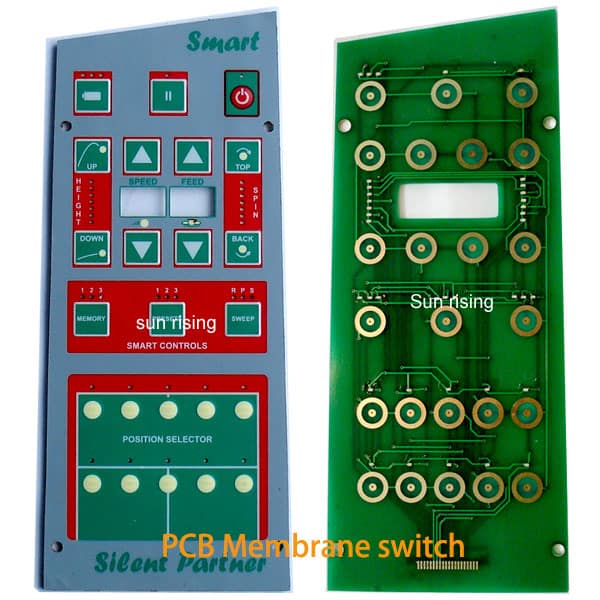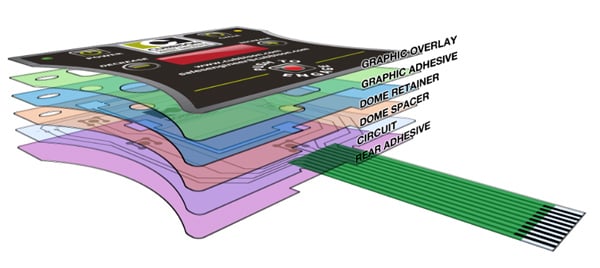The Future of Membrane Switch Technology in the Automotive Industry
The Future of Membrane Switch Technology in the Automotive Industry
Blog Article
Why Membrane Switches Over Are Important for Resilient Control Solution
Membrane layer buttons play a critical role in making sure the resilience and integrity of control systems throughout various sectors. As we check out the complex advantages of membrane layer buttons, it ends up being evident that their relevance goes beyond simple performance, influencing individual experience and functional efficiency.
Summary of Membrane Layer Switches
Membrane buttons are flexible and reputable parts commonly utilized in different electronic control systems. These switches contain numerous layers, consisting of a visuals overlay, a spacer layer, and a printed circuit layer. The visuals overlay supplies both useful and visual design, while the spacer layer ensures that the switches are activated just when pushed. The published circuit layer has conductive traces that complete an electrical circuit when the membrane is pushed, enabling the device to respond to user inputs.
Membrane layer switches are typically favored in applications requiring a compact and lightweight style, making them suitable for portable gadgets, medical equipment, and commercial equipment. They can be tailored to satisfy certain individual requirements and can include various features such as backlighting, responsive comments, and several colors. Furthermore, membrane switches are immune to dirt, moisture, and contaminants, making them ideal for environments where durability is essential.
Benefits of Toughness
In numerous applications, the resilience of membrane layer changes deals significant benefits that enhance their total performance and reliability. These buttons are designed to hold up against extreme environments, making them excellent for use sought after conditions such as high humidity, severe temperatures, and direct exposure to chemicals. Their robust building aids to stop damages from physical effect, making sure durable performance and minimizing the requirement for constant replacements.
Furthermore, membrane buttons are resistant to use and tear, which is crucial in applications where regular interaction occurs. This longevity equates to decrease upkeep costs, as companies benefit from minimized downtime and fewer service disruptions. Furthermore, the encapsulated layout of membrane switches secures inner components from dirt and wetness access, more adding to their lifespan.
Another advantage is their capability to maintain constant performance gradually. With a high resistance for mechanical stress and anxiety, these switches preserve their tactile feedback and electrical integrity, guaranteeing user satisfaction. Ultimately, the sturdiness of membrane changes not only improves functional performance however likewise promotes confidence in their integrity, making them a preferred choice for control systems across numerous fields.
Applications in Numerous Industries
Long lasting control systems using membrane layer buttons discover comprehensive applications across a series of markets, each gaining from the distinct attributes these buttons supply. In the medical market, membrane layer switches are important for devices such as client displays and analysis tools, where reliability and ease of cleaning are extremely important. Their resistance to wetness and contaminants ensures they preserve capability in clean and sterile environments.
The automotive market leverages membrane buttons for dashboard controls and infotainment systems, where they offer streamlined, low-profile interfaces that improve user experience. These buttons are additionally created to withstand rough conditions, consisting of exposure to extreme temperature levels and vibrations.
In commercial settings, membrane layer buttons are generally utilized in equipment control panels, supplying tactile responses and durability necessary for high-usage applications. Their capability to resist chemicals makes them appropriate for making atmospheres where spills and pollutants are frequent.

Customer electronics, such as kitchen area appliances and push-button controls, additionally utilize membrane switches for their convenience and cost-effectiveness. Overall, the adaptability and robust nature of membrane changes make them indispensable across different markets, guaranteeing effective procedure and long life in control systems.
Layout and Aesthetic Allure
While performance is vital, the style and visual allure of control systems outfitted with membrane layer switches play a vital duty in customer involvement and overall experience (membrane switch). The visual layout of these buttons can significantly influence user perception and communication. A properly designed membrane layer button boosts the good looks of the tool, making it extra enticing to users and fostering a connection in between the customer and the item
Membrane switches offer a good deal of flexibility in style, permitting makers to personalize graphics, colors, and textures to align with brand name identification and product aesthetic appeals. The use of dynamic colors and distinct patterns can attract attention, while responsive responses can strengthen the user's communication with the gadget. In learn the facts here now addition, the ability to incorporate LED signs and backlighting into the membrane layer button layout supplies both useful and visual benefits, boosting exposure and functionality in different atmospheres.
Enhancing Individual Experience

Furthermore, membrane switches can be tailored to integrate visual user interfaces, improving functionality by offering information in a clear and user-friendly fashion (membrane switch). This personalization can consist of icons, tags, and shade coding that overview customers via facility capabilities effortlessly. In addition, their versatility permits integration in various environments, ensuring consistent performance whether in commercial machinery or consumer electronics
The sturdiness of membrane switches also plays a critical function in user experience. By a fantastic read withstanding harsh problems and expanded usage, these buttons reduce the likelihood of system failings, therefore promoting reliability and customer self-confidence. Inevitably, the strategic use of membrane layer changes not only boosts capability however also considerably enriches customer interaction with control systems, making them an important component in modern-day style.
Conclusion

Report this page